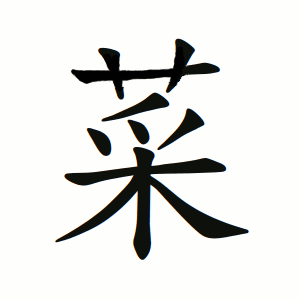菜
- vegetables, greens, edible plants;
By extension, food prepared from plants — i.e., dishes, side dishes, or cuisine.
In Chinese, 菜 has two main senses:
Plant-based food — vegetables and edible greens (蔬菜, “greens and vegetables”).
Prepared dish or course — any item of cooked food (菜肴, “dishes and meats”).
Thus in modern usage, 菜 may refer both to the raw ingredient (“vegetable”) and to the prepared meal (“dish”).
In Korean, it primarily means vegetable or side dish (나물, 반찬).
Etymology
Phono-semantic compound consisting of:
艸 (풀 초) — semantic component, indicating vegetation or plants.
采 (풍채 채 / 딸 채) — phonetic component, meaning “to gather,” “to pick,” and providing the sound chae.
Hence, the original sense of 菜 is “plants gathered for food” — wild herbs and greens picked from nature.
It is derived from the verb 采 (“to pick, to gather”), with the grass radical added to specify the object being gathered — herbs or vegetables.
In Shuowen Jiezi (說文解字):
「菜,蔬也。从艸,采聲。」
“菜 means vegetable; composed of 艸 (‘grass’) and the sound 采.”
Usage in Korean
蔬菜 (소채) — vegetables, greens
野菜 (야채) — wild herbs, uncultivated vegetables
菜肴 (채요) — dishes, food
菜食 (채식) — vegetarian diet
菜單 (채단) — menu (lit. “list of dishes”)
菜湯 (채탕) — vegetable soup
菜園 (채원) — vegetable garden
家常菜 (가상채) — home-cooked food
冷菜 / 熱菜 — cold dish / hot dish
好菜 — delicious dish
Words that derived from 菜
Additional notes
The Kangxi Dictionary (康熙字典) defines:
「菜,蔬也。凡可食之草曰菜。」
“菜 means vegetable; all grasses that can be eaten are called 菜.”
In early agrarian texts such as Qimin Yaoshu (齊民要術), 菜 denoted cultivated greens like cabbage, leek, garlic, and spinach, distinguishing them from 蔬 (“wild greens” or “herbs”).
In Confucian and Buddhist contexts, 菜 symbolizes simplicity and moderation — food gathered from the earth, not killed from flesh.
“食菜不厭素” — “One who eats vegetables without disdain for their plainness” — is praised in moral literature as a mark of virtue.
In Daoist imagery, 菜 and 蔬 are emblems of natural living (清淡之食), the nourishment of both body and spirit.
In daily language, 家常菜 (“ordinary family dishes”) embodies warmth, balance, and contentment — the harmony of everyday life.
In modern Chinese, the word 菜 further extended to mean:
Cuisine type: e.g. 川菜 (Sichuan cuisine), 韓菜 (Korean cuisine), 粵菜 (Cantonese cuisine).
Cooking skill: 菜得很 (colloq.) — “to be bad at (a game, skill),” derived metaphorically from “bland, weak.”
In literary Chinese, 菜 sometimes refers to plain, humble fare, in contrast to rich foods.
E.g., 菜羹 (채갱) — vegetable soup, the food of the virtuous poor.
「蔬食菜羹,甘如醴也。」 (論語·鄉黨)
“A simple meal of vegetables and soup can taste as sweet as wine.”
In Korean, 菜 survives chiefly in compounds such as 蔬菜 (소채) and in traditional expressions for vegetables or side dishes (나물, 반찬).
菜 is a phono-semantic compound (艸 + 采) meaning “vegetable,” “greens,” or “dish.”
It originates from the act of gathering herbs (采), and came to denote both the raw plant and the prepared meal.
Across cultures, it represents simplicity, nourishment, and home life — food gathered from nature and shared in peace.
- 廿月木 (TBD)
- ⿱ 艹 采
